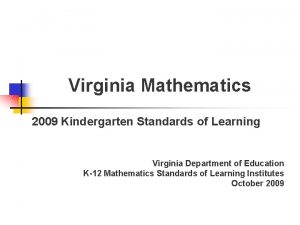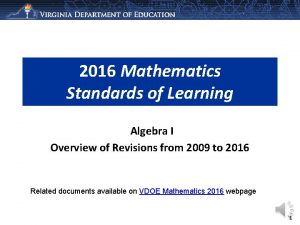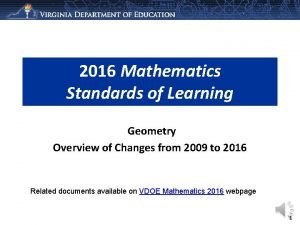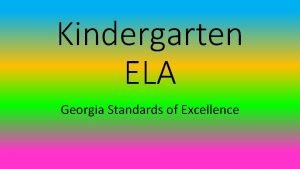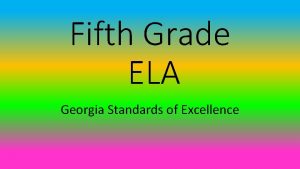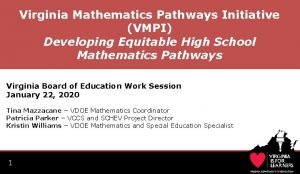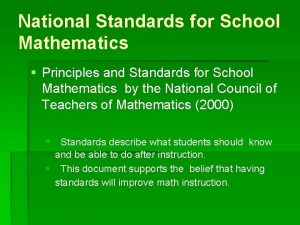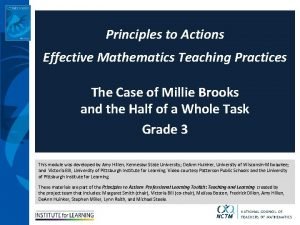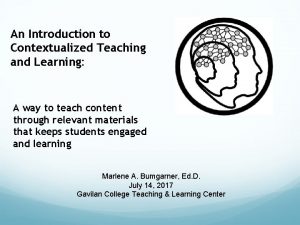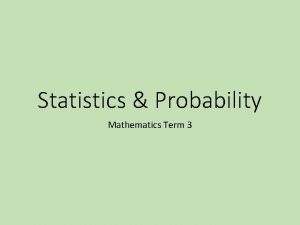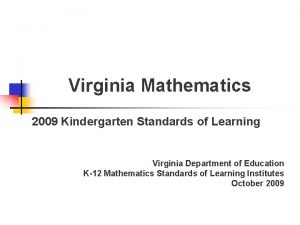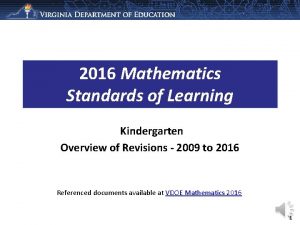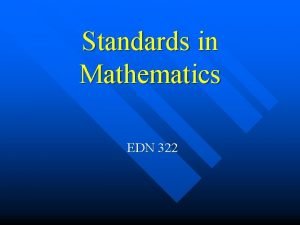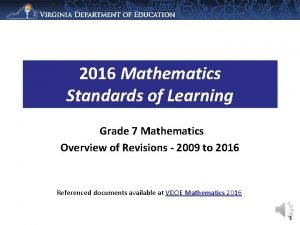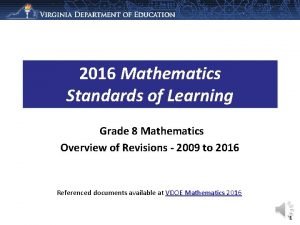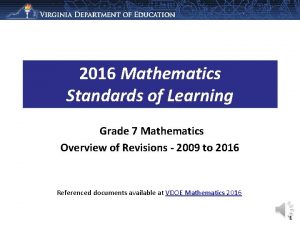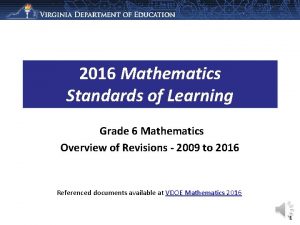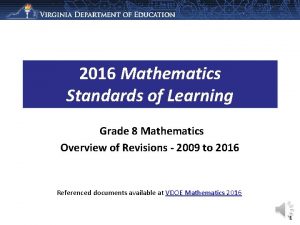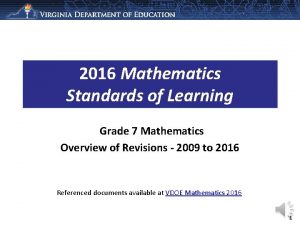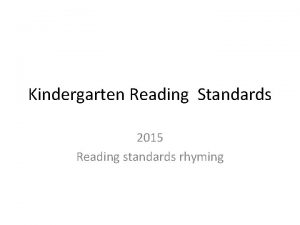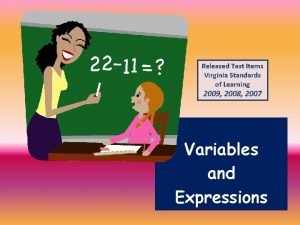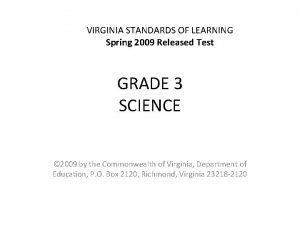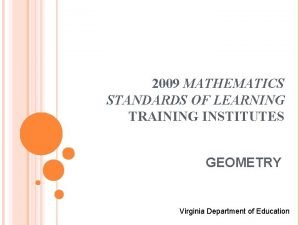Virginia Mathematics 2009 Kindergarten Standards of Learning Virginia



















- Slides: 19

Virginia Mathematics 2009 Kindergarten Standards of Learning Virginia Department of Education K-12 Mathematics Standards of Learning Institutes October 2009

Major SOL Changes Number and Number Sense n n Count forward to 100 (previously to 30). Identify one more than and one less than a number. Ordinal numbers first to tenth (previously first to third). Identify halves and fourths.

Major SOL Changes Computation and Estimation n Model addition and subtraction with numbers to 10.

Major SOL Changes Measurement n No change.

Major SOL Changes Geometry n Trace geometric figures.

Major SOL Changes Probability and Statistics n Answer questions related to collected data.

Major SOL Changes Patterns, Functions, and Algebra n No change.

Major Changes Related SOL have been combined to create one SOL with bullets. EX: n (2001) K. 4 The student will investigate and recognize patterns from counting by fives and tens to 30, using concrete objects and a calculator. K. 5 The student will count forward to 30 and backward from 10. (2009) K. 4 The student will a) count forward to 100 and backward from 10; b) identify one more than a number and one less than a number; and c) count by fives and tens to 100.

Major Changes Details on instructional strategies have been removed for potential placement in the curriculum framework. EX: n (2001) K. 3 The student, given an ordered set of three objects and/or pictures, will indicate the ordinal position of each item, first through third, and the ordered position of each item from left-to-right, right-to-left, top-to-bottom, and/or bottom-to-top. (2009) K. 3 The student, given an ordered set of ten objects and/or pictures, will indicate the ordinal position of each object, first through tenth, and the ordered position of each object.

Counting forward to 100 Kindergarten students should have multiple experiences with counting larger numbers including (but not limited to): § calendar time; hundred chart activities; days in school (100 th day celebration); and § collecting data. § §

One more than, One less than n n The one more than (one less than) number relationship is key to building early number sense, a flexible concept of number not completely tied to counting. While students are generally familiar with the concept of more, they have had less experience with the term less. The terms should be used together to emphasize the relationship.

One more than, One less than Instructional activities might include (but not limited to): n matching dominoes; n arranging dot cards; n plus one on the calculator; n hundred chart; and n ten frames.

Counting sets, writing, recognizing numbers to 15 Important underlying concepts should include: n conservation of number; n one-to-one correspondence; n the cardinality principle; and n understanding of 0 as a digit and a number.

Counting sets, writing, recognizing numbers to 15 Instructional activities might include (but not limited to): n counters on ten frames; n connecting cubes; n sets of objects in patterned arrangements; and n kinesthetic experiences forming numerals.

Ordinal numbers first to tenth Connections to daily experiences including (but not limited to): n lining up; n calendar; n block towers; n figures in patterns; and n letters in a name/word.

Identify halves and fourths Two models n Set n Region

Identify halves and fourths The emphasis is on concrete representations and vocabulary in familiar context including (but not limited to): n food (half a cookie); n geometric shapes (one fourth of a circle); n folding (a sheet of paper into fourths); and n cutting (half the ribbon). Symbolic representation is not a focus at the kindergarten level.

Model addition and subtraction Experiences with addition and subtraction should be tied to real world contexts and/or concrete materials and include a variety of structures including: n join n separate n part-whole n compare Symbolic representation is not a focus at the kindergarten level.

Answer questions related to data Everyday experiences offer many opportunities for collecting data, including (but not limited to): n attendance; n lunch count; n making choices; and Related questions should focus on connecting number concepts such as part-whole and comparison (greatest, least, same).
 2009 mathematics standards of learning answers
2009 mathematics standards of learning answers 2016 mathematics standards of learning
2016 mathematics standards of learning 2016 mathematics standards of learning
2016 mathematics standards of learning Georgia kindergarten ela standards
Georgia kindergarten ela standards Georgia kindergarten reading standards
Georgia kindergarten reading standards Oregon early learning and kindergarten guidelines
Oregon early learning and kindergarten guidelines What is vmpi
What is vmpi Principles and standards for school mathematics
Principles and standards for school mathematics Delmar cengage learning medical terminology
Delmar cengage learning medical terminology 2009 delmar cengage learning
2009 delmar cengage learning Chapter 1 introduction to medical terminology answer key
Chapter 1 introduction to medical terminology answer key Measuring and recording apical pulse
Measuring and recording apical pulse Chapter 6 skeletal system
Chapter 6 skeletal system 2009 delmar cengage learning
2009 delmar cengage learning 2009 delmar cengage learning
2009 delmar cengage learning Cuadro comparativo e-learning y b-learning
Cuadro comparativo e-learning y b-learning Establish mathematics goals to focus learning
Establish mathematics goals to focus learning Contextualized learning examples
Contextualized learning examples Learning intentions and success criteria for mathematics
Learning intentions and success criteria for mathematics Northern virginia seo
Northern virginia seo
